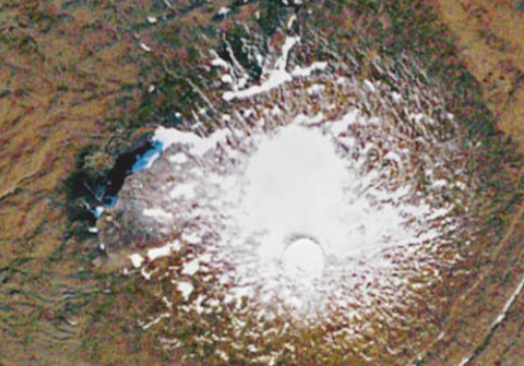It also held the water that fed local streams and sustained the local population, pouring it out as if from buckets balanced on the yoke of the mountain. Its water was very cold, very old, and pure. Icelanders might overlook Ok, but those who had drunk its water remembered with pleasure how it tasted, and imagined the little glacier would always go on giving.
它還儲存著當地溪流的水,維持著當地居民的生活,像是從平衡在山上的桶里倒出來一樣。那的水非常涼,非常古老,也很純凈。冰島人可能會忽略OK島,但是那些喝過它的水的人愉快地記得它的味道,想象著這個小冰川會不斷的融化。
In 1890 geologists estimated that Ok covered 1,600 hectares, or 6.2 square miles. (On one map of 1901 it seemed to spread even farther, to 3,800 hectares.) Gradually and quietly, through the 20th century, it dwindled away. In 1945, it covered only 500 hectares; in 1978, 300; in 2012, about 70. The next year Oddur Sigurosson, a glacier expert at the Meteorological Office, paid his "good friend" a close visit. What he found was, by then, obvious: the snow on Ok was melting faster than it could be replaced.
1980年,地理學家估計OK島占地1600公頃,或6.2平方英里。(在1901年的一張地圖上,它似乎更大,有3800公頃。) 逐漸地,隱秘地度過20世紀后,它就要消失了。1945年,它僅僅占地500公頃;1978年為300公頃;2012年只有大約70公頃。第二年,氣象局的冰川專家奧杜爾·西古德松拜訪了他的“好朋友”。那時,他的發現是顯而易見的:OK島上的雪融化的速度快的無法彌補。

The ice had become so thin that "he" was no longer moving. Mr Sigurosson later recorded the death on an official certificate, attributing it to "excessive summer heat caused by humans". Not many of those humans seemed to notice, in Iceland or elsewhere. Ok had never drawn the tourists and the snowmobilers. So as it shrank yet more, to a patchy snowfield and a crater lake, there was no general outcry.
冰變得太薄了,他不能再動了。西古德松先生后來將死亡記錄在官方證書上,將其歸因為“由人類帶來的過量夏熱”。不論在冰島還是別的地方,沒有多少人注意到這件事情。OK從沒吸引到游客或駕雪車的人。因此,當它進一步縮小,變成一片零散的雪地和一個火山口湖時,并沒有引起普遍的抗議。
譯文由可可原創,僅供學習交流使用,未經許可請勿轉載。












